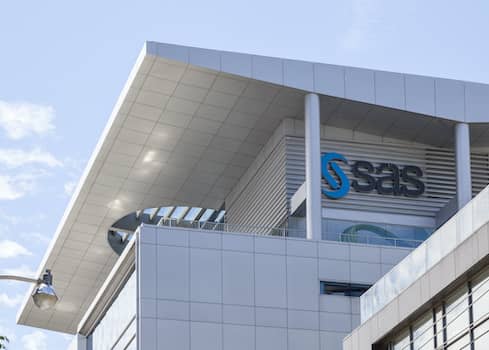SAS Founders Call Off Sales Talks with Broadcom
Longtime analytics giant SAS briefly entertained the idea of being acquired by semiconductor giant Broadcom. Now that the talks are off, what's next for the 45-year-old enterprise stalwart?

For a few hours in the last week, it looked like longtime enterprise analytics leader SAS might finally actually be sold to a larger tech company, paving the way to a potential retirement or full-time philanthropy focus for its 78-year-old co-founder, co-owner, and CEO, Jim Goodnight, and a new owner for the company's portfolio of enterprise analytics offerings.
A report in the Wall Street Journal on July 12 said that 45-year-old SAS was in talks with semiconductor giant Broadcom for a sale of the company, citing sources close to the matter, and then a day later the Wall Street Journal reported that those talks were over and no deal would happen after SAS' owners changed their minds.
Broadcom would not be an obvious choice as an acquirer of SAS, but the chip company has made some investments in the enterprise software market in recent years, including assets of CA Technologies and Symantec.
The sale could have been a big deal to enterprise organizations because many of them have been standardized on SAS analytics software for years. SAS says that 91 of the Fortune 100 companies use SAS software. Customers include Honda, Chico, DSW, Discover Financial Services, the LA Kings, Lockheed Martin, and many others.
"SAS has become an essential part of the world's largest enterprises for important activities like forecasting and making predictions about markets. It is enmeshed in all these enterprises," Forrester VP and analyst Mike Gualtieri told InformationWeek. "SAS has been around since the 70s, and it was basically alone in the analytics space. No one could touch it."
Gualtieri noted that SAS customers generally have two concerns about the company -- the pricing and the fact that the next generation of data scientists has standardized on a different set of tools.
Younger data scientists have shown a preference for open-source tools such as R and Python, yet the enterprise establishment is still a SAS stronghold.
"SAS has had so much investment in R&D that its products have stayed ahead of most other companies, including startups," said Gualtieri. "However, they have a reputation among new data scientists as being a dinosaur -- slow to embrace open source and the cloud."
But that's something that SAS has been working to change. Shifts in the market, both toward open-source tools and cloud vs. on-premises software, haven't been ignored by SAS executives. For instance, SAS introduced the concept of SAS ModelOps nearly 2 years ago in 2019, as a package of technology and advisory services designed to streamline the management, deployment, monitoring, retraining, and governance of both SAS and open-source analytical models.
At the time in 2019 CTO Oliver Schabenberger told InformationWeek: "I see our role increasingly as an integrator of analytics." Schabenberger left SAS in January 2021 to join SingleStore (formerly known as MemSQL) as chief innovation officer after that company's most recent round of new funding, leaving SAS without an obvious successor to Goodnight, another reason why the company's owners may be looking at a sale of the company as an exit strategy.
SAS has also made inroads in its cloud efforts. SAS released its cloud-based platform, SAS Viya on Microsoft Azure in November 2020 and in May 2021 added cloud-native support for the platform on AWS and Google Cloud with plans to add Red Hat OpenShift later this year.
SAS has been modernizing its portfolio to match the realities of today's data scientists and customers.
Forrester VP and analyst Boris Evelson said that the idea of SAS being in sales talks was no surprise. There have been rumors of such talks for many years, he noted.
"It's hard for an independent pure-play to survive these days," he said. "The pricing pressures are tremendous. Microsoft, Amazon, and Google are giving away data and analytics products at low costs because they want to attract customers to their cloud platforms."
However, the concept of Broadcom as an acquirer of SAS was a bit of a surprise to both Evelson and Gualtieri given the lack of any overlap whatsoever in the companies' portfolios.
"I see no product synergies. It's almost like it would be a separate division," Evelson said.
Perhaps that's what SAS founder Goodnight had in mind. The company he built and now operates mostly from a huge campus in Cary, North Carolina, is well-known for its positive employee culture, 35-hour workweeks, on-campus childcare and cafeterias where Goodnight himself eats lunch, and private offices for most workers. The company invests 20% or more of revenues towards R&D each year and over many years has ranked on many lists of Best Places to Work. It would make sense that Goodnight is looking to pass on this company he built to a caretaker who would continue its legacy into the next 45 years rather than subsume it and its culture.
I interviewed Goodnight only once back in 2017, and during that conversation he was less interested in talking about his software's new capabilities and most interested in talking about hardware and chips, and how advances in that separate but related area would lead to advances in analytics. I'm not the only tech journalist who has listened to Goodnight express deep interest in the hardware side of the technology.
Broadcom may have been a surprise as a suitor for SAS, but perhaps the idea of a semiconductor company or another kind of hardware company is not so farfetched. A buyer with no overlap in products would potentially mean layoffs could be minimized.
Maybe a semiconductor company with a similar culture (which is something Broadcom lacked) and an interest in what hardware can do to advance AI and analytics will ultimately become the kind of suitor that Goodnight would want as the caretaker of the SAS culture and mission for the next 45 years.
What to Read Next:
IT Pro Salary Survey: What You Earned in 2020
Four Best Practices for Successful AI Projects
CTOs Evolve in Shake Up of Digital Leadership in the C-Suite
Why You Need a Data Fabric, Not Just IT Architecture
About the Author(s)
You May Also Like
How to Amplify DevOps with DevSecOps
May 22, 2024Generative AI: Use Cases and Risks in 2024
May 29, 2024Smart Service Management
June 4, 2024







